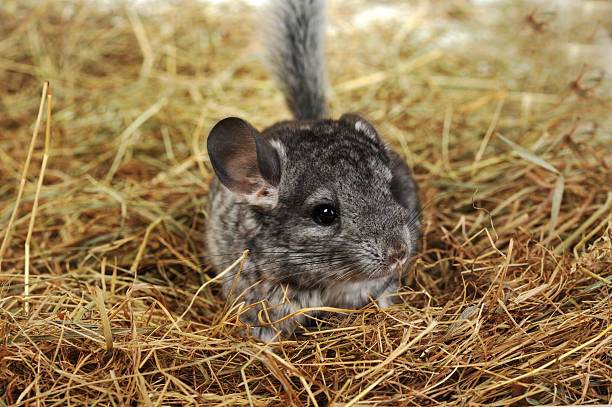Before chinchillas move in with you, you need to design the chinchilla home. In order for your chinchillas to stay healthy and happy, it has to meet a few requirements. Here you can find out what you have to pay attention to when buying and designing the chinchilla enclosure.
Chinchillas are very active. When they are awake, they gymnastics, jump, and run around the cage for hours. To do this, they need a lot of space, suitable interior furnishings and one or more conspecifics. Keeping chinchillas alone is not species-appropriate!
The size of the chinchilla enclosure

In general, a cage can only be too small, never too big. A cage that is too small can cause the chinchillas to develop behavioral problems or become ill. There are many cages available in pet shops, but only a few meet the minimum dimensions. Above all, height is important because chinchillas like to have a good overview.
Spacious, rodent-proof aviaries with a minimum volume of 3m³ for two animals are suitable as chinchilla enclosures. The aviary should be at least 50 cm wide and 150 cm high. An additional 0.5m³ of space must be available for each additional animal. These requirements are met, for example, by this small animal cage from Petgard*.
Build your own chinchilla enclosure
Alternatively, you can build a chinchilla enclosure yourself. This is not that difficult and offers the advantage that you can make it much larger and according to your own wishes.
With a little craftsmanship, you can make a nice, large enclosure out of a few chipboards and wires. The mesh size of the wire should be 1 to 1.5 cm. Wood and wire are available in almost every major hardware store. You can also convert an old cupboard or a large bird aviary into a chinchilla home. However, a large, self-made cage in no way replaces the daily free run. Even the largest enclosure is explored at some point and gets boring.
The interior of the chinchilla enclosure
No chinchilla feels comfortable in an empty cage. First, the bottom of the cage must be provided with bedding. Hemp, linen, corn, or wood litter is suitable for this. The wooden litter from Jelu*, for example, is ideal. Cat litter and straw are not suitable.
The right interior design is also important for chinchillas to feel comfortable and to be able to hide and occupy themselves in their enclosure. The facility should be three-dimensional. The following items should not be missing:
- Seat boards on at least three floors that can only be reached by jumping
collapsed rock formations - thick branches (branches from willow, beech, hazelnut, spruce, and unsprayed fruit trees are safe to use.)
- Ramps, climbing possibilities
- Hiding places, e.g. fabric caves*
- Sand bath with chinchilla special sand*
- Food bowl (heavy, e.g. made of a Kramnik bowl*, so that it doesn’t fall over so easily)
- Nipple drinker and water bowl or an automatic water dispenser*
- hay rack*
Sleeping houses (each 30 x 20 x 20 cm) such as the wooden bungalow from Resch*
It is best to place the sleeping box on the highest seat board, as chinchillas like to be in the upper part of the cage. Make sure the cottage is securely fastened and cannot fall. If your animals feel like sleeping a little deeper, you can also offer them a second house or a clay tube on the floor of the cage.
The chinchilla room

If you have a large apartment or house, you may even be able to give your chinchillas an entire room. Chinchillas are extremely active. They have a great need to move and jump, especially at night. In the cage, they cannot satisfy their urge to move and they will not be able to give you access to exercise in the middle of the night. In a separate room, on the other hand, the animals have far more space to romp and run.
The basic equipment of the room is the same as in a cage. In addition, you can let your imagination run wild and create an exciting and large adventure playground with branches, seating boards, old tables, and chairs. Also, remember to install an escape-proof barrier so that you can safely open the room door.
You should make sure that the room is rodent-proof, for example, no cables are lying around or there are no plants in the room that are poisonous to chinchillas. Even if the room is large, it still does not replace the daily free run.